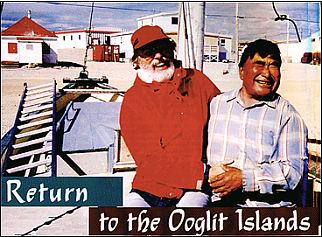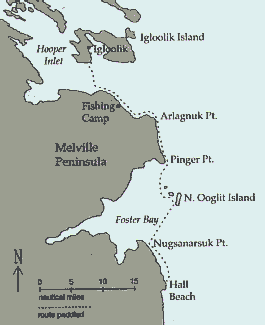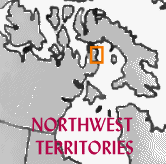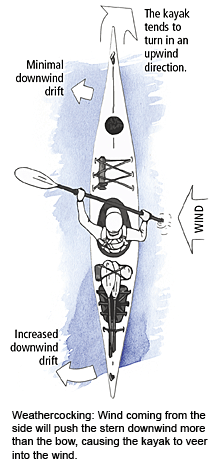Laurie’s voice leapt out of the telephone one Friday night. Hey, Mary! Bruce and I are going out tomorrow evening for a short overnight – want to join us? We’ll put in at Northfield at six, paddle up to the lean-to at Munn’s Ferry, and camp there, then paddle back on Sunday morning. We’ll be back at the cars before noon. We don’t have the whole weekend free for a trip, but we’re itching to get out on the water.
As she spoke, I did a quick mental review of my weekend schedule. No problem fitting in this short trip. I remembered that the morning forecast had been for a cool, cloudy weekend, but there were no big storms coming in. What about gear? It was March, the off-season in Massachusetts, and I hadn’t been out much over the winter, but all my gear was accessible and ready to go.
Sounds like a great idea, I said. What about food?
We’ll eat an early supper before we put in. Bruce is in charge of bacon and eggs for Sunday morning. Bring your favorite hot beverage, and some of those divine lemon ginger scones.
After the phone call, I walked over to my desk, pulled out my kayak gear list folder and flipped through it to the list for overnight trips. If it were the middle of summer, I would hardly need to look at it, but in March, the overnight list helped to jog my memory. In short order, I’d be fully prepared and equipped for a mini-vacation.
Sounds simple and delightful? It was, largely because of our ready-to-go attitudes, the nearby spots to overnight, and especially the systems we use for keeping our kayak gear organized. Often, one of the biggest barriers to getting out kayaking for most paddlers is scattered or unready gear. With some pre-planning, the right attitude and gear systems, you can easily get out on the water more often. Efficient gear systems can help you be ready to seize opportunities when they arise. You’ll also ensure that you won’t arrive at the launching site and realize your VHF radio batteries are on their last legs or that you forgot your flares.
Gear
A number of my paddling friends have told me they envy how often I go paddling. Having a flexible schedule helps, but a key component to how I get out on the water so frequently is my gear systems. For paddlers without efficient gear systems, packing for any trip is like packing for the first trip of the season: they are out of practice and their gear is buried under other stuff. I know many kayakers who would like to paddle more frequently, but they are put off by the time and hassle required to get all their gear ready to go. It is also not unusual for paddlers to rush through their preparation and head off on a trip without all the gear they need.
Keeping kayak gear handy is part of my daily routine in the six months of prime New England paddling season. To facilitate this routine, I have developed pre-trip, on-the-water, and post-trip systems.
Pre-trip
Develop a list of the gear you need for different trip lengths and seasons. (See list on following page for guidelines.) You should have all of the gear appropriate for the paddling you are doing, a place to store it between trips, and a system for maintaining and organizing it. For my almost-daily paddles in the summer, I use my car as a boathouse. Stuff packed in a car may be subject to high heat. I don’t store heat-sensitive items like my camera, radio, or drysuit in the car, but some of my more low-maintenance gear stays in my car all summer. I have a dry bag – my ‘day pack’- and a plastic bin that holds my PFD, pump, paddle float and paddling clothes and shoes. The plastic storage bin keeps the car dry when I dump in wet gear after an outing.
I keep my kayak locked on top of my car. I made a cover of sun-protective cloth to preserve the boat from harmful rays. I keep a gear checklist on my dashboard and double check it before I leave home to make sure I have everything. Every day in the summer, when I head out from the house to go to work or wherever, I sit in the car before driving off and I run down my list, reviewing what I need for the day.
Not everyone has a car they use for a boathouse. Most paddlers, however, can turn some part of their home into an efficient boathouse, by creating spaces to store and maintain their gear. Buy or build storage bins to hold equipment between trips, preferably near where you can hang wet gear to dry. If you use rechargeable batteries for your VHF radio or other electronics, it is handy to have an outlet nearby where you can plug in a charger.
Figure out which gear needs which type of storage area, especially in terms of temperature and dryness. Some equipment, especially dry suits and neoprene paddling clothing, should be rinsed and hung in a cool dry place rather than be packed away. Any dampness may lead to mildew. To transport equipment between your storage areas and your car or launching spot, develop a system such as using bags or portable bins. Such a routine will help you make sure you have everything, and will take less time than if you’re juggling lots of loose items.
On the water
Figure out standard places to stow gear on or in your boat, including how many and what size dry bags or other gear containers you need. Once you’ve developed your packing system, label the bags with where they go in your boat and what they contain, for example, bow, spare clothes; aft bulkhead, cooking gear. (While you’re at it, mark the bags with your name and phone number.)
I always carry one or two flotsam bags on kayak trips. They are nylon mesh bags with carry handles – the kind sold as reusable grocery bags. I’ve found that, even with a variety of gear storage systems, my cockpit carries a variety of flotsam on every trip: snack bags, water bottle, sunscreen, boat horn, etc. I use flotsam bags for carrying that gear to and from the boat and generally containing it. On a five-week trip in Prince William Sound, Alaska, I used a flotsam bag for carrying my thermos, water bottle, snack bag, seat cushion, and neoprene mukluks to and from the boat. The last stage of packing was to take off my heavy rubber boots, put on the mukluks, stow the boots and all the flotsam, then hop in the boat. Having the right size and quantity bags and a boat-loading routine streamlines the tasks at the launch site and when unloading at a campsite. Before going out on a trip in a new boat, take some time in the backyard or somewhere else where you can really figure out the optimal way to load your gear. When you’re packing at the end of the day or the end of the trip, put gear back into the same bags. You’ll save time and have more room if you develop a reliable system and stick to it.
Using a standard boat-packing system can also serve as a good backup to check that you have all of your gear. I figured this out when I got to the end of the first day of a three-day solo trip in Maine and realized I’d left my food bag in my car. I had been really proud of myself when I packed my boat at six that morning because it seemed as though there was lots of extra room in the boat. The food bag left buried in the car was the reason for the extra room. Now packing my boat allows me a chance to review what gear I have with me. Extra room is no longer reason to pat myself on the back for packing so efficiently – it is my cue to double check the gear lists and gear bags.
Post-trip
How you handle your gear after a trip is key to making future trips easy. When I get home from a trip, everything wet gets pulled out of the car and put onto the outdoor clothesline where I can rinse it off with fresh water from the hose nearby. Depending on the weather, it either gets left on the line or put on a clothesline in the garage to dry. Your gear will last longer if you don’t leave it in direct sunlight. Rinse the inside of your dry suit occasionally. One of my friends made a rack of plastic pipes for holding booties, hoods and gloves to drain and dry.
Part of my routine the morning following a trip is to gather up the dry gear and put it back into its places in the car – or off-season, onto shelves in the garage. I post a whiteboard or pad of paper and a pen next to my gear storage so I can keep a running list of gear that needs replacement, new gear I need, or repairs that need to be done before the next trip. Part of your post-trip routine can be checking battery levels to see if they have enough charge left for the next trip. If not, now is the time to recharge them.
It’s true that you often have to take as much gear for a weekend trip as you take for a month-long trip. One of the secrets of getting out often is paring down the amount of gear you take to an absolute minimum to achieve your safety and comfort needs. This is where a list comes in handy for taking just what you need, but not too much. Even though your basic gear list may be simple, one of the luxuries of short trips is being able to take along treats that wouldn’t be possible on long trips. I take a stove on day trips, especially when the weather is cold, and treat myself to hot drinks and maybe even warmed leftovers from last night’s supper. During the summer, I may take a soft-sided cooler. A pound of dry ice from the supermarket will keep some special summer treats, even ice cubes and ice cream, frozen for hours. (Make sure your bulkheads are vented to bleed off the CO2 the dry ice gives off.) Since you have room to spare on short trips, you can afford to make the trip memorable by its indulgences.
Keep your preparation and driving time to paddling time ratio weighted toward paddling time. It’s fine to spend months planning an expedition and days driving to get there. You’ll get out more often if the shorter outings you take require little preparation and driving.
People
Choose your companions wisely, as you would for a longer expedition. Be sure to go out with folks who are looking for the same type of experience you are. It helps to go with experienced paddlers/campers, but what matters most is attitude. It also helps if they have developed their own efficient gear systems. You don’t want to waste the time you’ve saved with your gear system while you wait for someone to root around in closets searching for paddling gloves.
I know that one of the reasons I got that call from Laurie inviting me out for a spur-of-the-moment overnight paddle was that she knows I’m ready to go on short notice and I’ll have all the gear I need.
Conditions
If preparing for a trip is a quick and easy process, you are in a better position to take advantage of brief windows of good weather in the off-season. Even if your plans for a quick get-away get foiled by lousy weather or rough water, it is easier to make the wise decision to go somewhere else or wait for another opportunity, because you haven’t invested a lot of time and effort getting yourself organized and to the launch site.
With efficient gear systems, you can take advantage of those lovely winter days when other paddlers are just beginning to wonder where they stashed their gear at the end of the last season. Most of us lead busy enough lives that we can’t get out on many long trips. However, with the proper preparation and attitude, you can make the limited time you have go a long way toward feeding your soul in some of the same ways a longer, more complex trip does. Whenever and wherever you go, you can get out of the house with a minimum of fuss and get on the water with the equipment you need to have a pleasurable and safe outing.


 Igloolik-A grand re-union with some old hunting pals. Here Enuki Kunnuk and I share a laugh about who was better fed over the years and who got older looking…In the background is the town of Igloolik. The small white building with the red roof is one of the last of the former Hudson’s Bay Company buildings remaining from the old days of the north.
Igloolik-A grand re-union with some old hunting pals. Here Enuki Kunnuk and I share a laugh about who was better fed over the years and who got older looking…In the background is the town of Igloolik. The small white building with the red roof is one of the last of the former Hudson’s Bay Company buildings remaining from the old days of the north.
 It had been a brief visit, but it was vividly etched in my memory. This was finally my chance to return. I would paddle from Hall Beach to Igloolik and, along the way, stop at the Ooglit Islands.
It had been a brief visit, but it was vividly etched in my memory. This was finally my chance to return. I would paddle from Hall Beach to Igloolik and, along the way, stop at the Ooglit Islands.